Coronary Heart Disease in the Indigenous Community in Australia
VerifiedAdded on 2022/12/30
|10
|2494
|372
AI Summary
This report discusses the impact of coronary heart disease in the indigenous community in Australia. It explores the challenges faced by public health and the implementation of policies to improve health conditions. The report includes literature reviews and research on risk factors and prevention strategies.
Contribute Materials
Your contribution can guide someone’s learning journey. Share your
documents today.
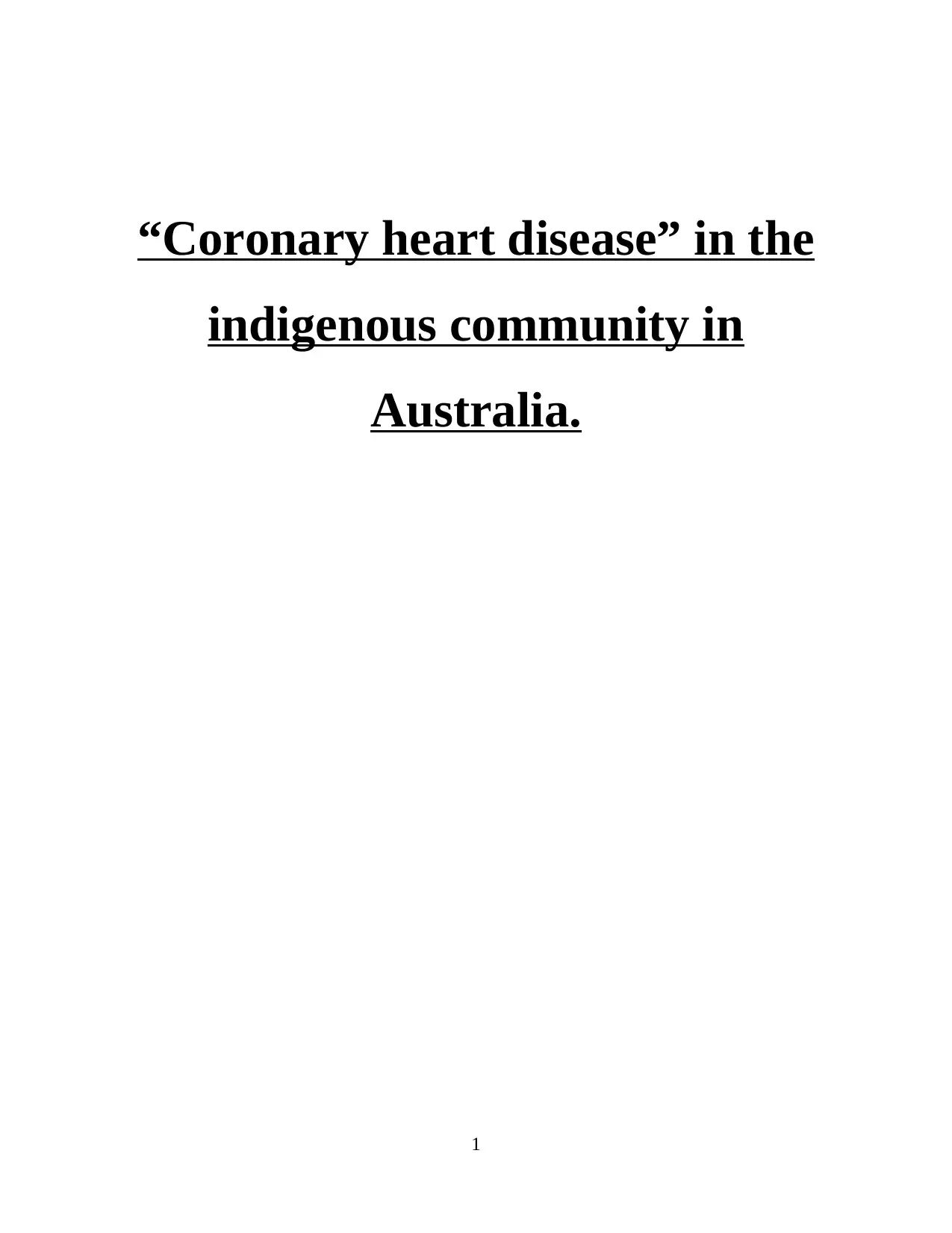
“Coronary heart disease” in the
indigenous community in
Australia.
1
indigenous community in
Australia.
1
Secure Best Marks with AI Grader
Need help grading? Try our AI Grader for instant feedback on your assignments.
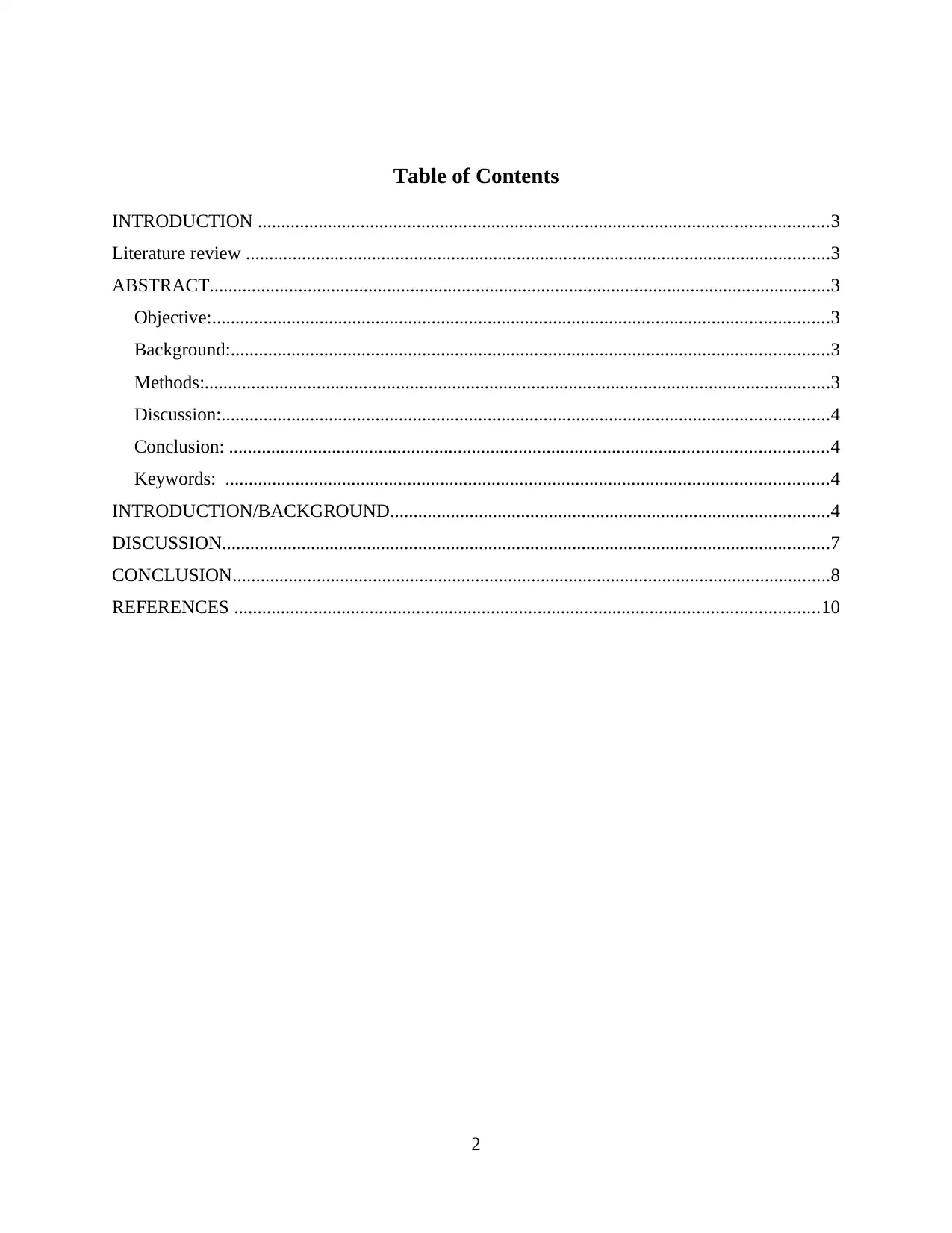
Table of Contents
INTRODUCTION ..........................................................................................................................3
Literature review .............................................................................................................................3
ABSTRACT.....................................................................................................................................3
Objective:....................................................................................................................................3
Background:................................................................................................................................3
Methods:......................................................................................................................................3
Discussion:..................................................................................................................................4
Conclusion: ................................................................................................................................4
Keywords: .................................................................................................................................4
INTRODUCTION/BACKGROUND..............................................................................................4
DISCUSSION..................................................................................................................................7
CONCLUSION................................................................................................................................8
REFERENCES .............................................................................................................................10
2
INTRODUCTION ..........................................................................................................................3
Literature review .............................................................................................................................3
ABSTRACT.....................................................................................................................................3
Objective:....................................................................................................................................3
Background:................................................................................................................................3
Methods:......................................................................................................................................3
Discussion:..................................................................................................................................4
Conclusion: ................................................................................................................................4
Keywords: .................................................................................................................................4
INTRODUCTION/BACKGROUND..............................................................................................4
DISCUSSION..................................................................................................................................7
CONCLUSION................................................................................................................................8
REFERENCES .............................................................................................................................10
2
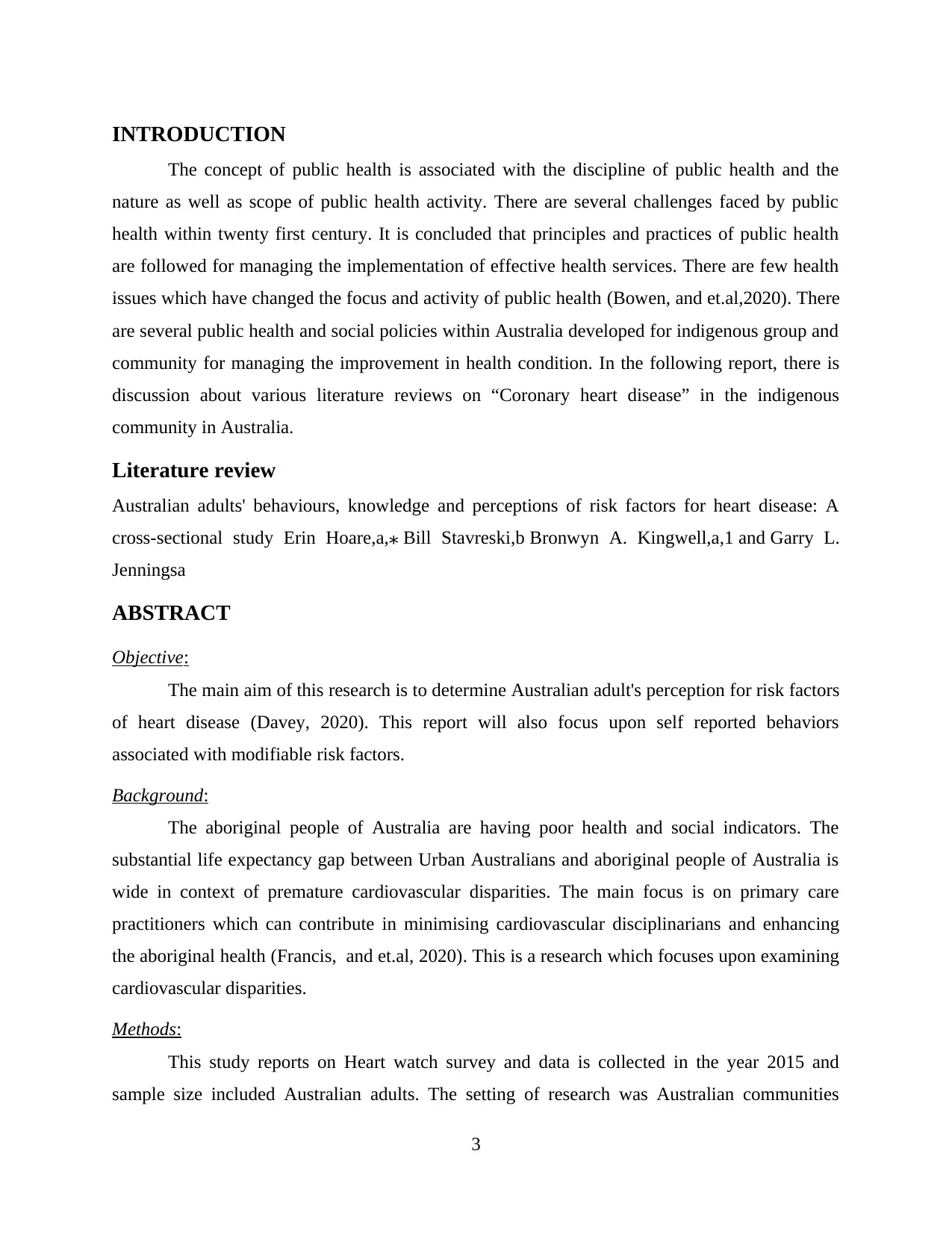
INTRODUCTION
The concept of public health is associated with the discipline of public health and the
nature as well as scope of public health activity. There are several challenges faced by public
health within twenty first century. It is concluded that principles and practices of public health
are followed for managing the implementation of effective health services. There are few health
issues which have changed the focus and activity of public health (Bowen, and et.al,2020). There
are several public health and social policies within Australia developed for indigenous group and
community for managing the improvement in health condition. In the following report, there is
discussion about various literature reviews on “Coronary heart disease” in the indigenous
community in Australia.
Literature review
Australian adults' behaviours, knowledge and perceptions of risk factors for heart disease: A
cross-sectional study Erin Hoare,a,⁎ Bill Stavreski,b Bronwyn A. Kingwell,a,1 and Garry L.
Jenningsa
ABSTRACT
Objective:
The main aim of this research is to determine Australian adult's perception for risk factors
of heart disease (Davey, 2020). This report will also focus upon self reported behaviors
associated with modifiable risk factors.
Background:
The aboriginal people of Australia are having poor health and social indicators. The
substantial life expectancy gap between Urban Australians and aboriginal people of Australia is
wide in context of premature cardiovascular disparities. The main focus is on primary care
practitioners which can contribute in minimising cardiovascular disciplinarians and enhancing
the aboriginal health (Francis, and et.al, 2020). This is a research which focuses upon examining
cardiovascular disparities.
Methods:
This study reports on Heart watch survey and data is collected in the year 2015 and
sample size included Australian adults. The setting of research was Australian communities
3
The concept of public health is associated with the discipline of public health and the
nature as well as scope of public health activity. There are several challenges faced by public
health within twenty first century. It is concluded that principles and practices of public health
are followed for managing the implementation of effective health services. There are few health
issues which have changed the focus and activity of public health (Bowen, and et.al,2020). There
are several public health and social policies within Australia developed for indigenous group and
community for managing the improvement in health condition. In the following report, there is
discussion about various literature reviews on “Coronary heart disease” in the indigenous
community in Australia.
Literature review
Australian adults' behaviours, knowledge and perceptions of risk factors for heart disease: A
cross-sectional study Erin Hoare,a,⁎ Bill Stavreski,b Bronwyn A. Kingwell,a,1 and Garry L.
Jenningsa
ABSTRACT
Objective:
The main aim of this research is to determine Australian adult's perception for risk factors
of heart disease (Davey, 2020). This report will also focus upon self reported behaviors
associated with modifiable risk factors.
Background:
The aboriginal people of Australia are having poor health and social indicators. The
substantial life expectancy gap between Urban Australians and aboriginal people of Australia is
wide in context of premature cardiovascular disparities. The main focus is on primary care
practitioners which can contribute in minimising cardiovascular disciplinarians and enhancing
the aboriginal health (Francis, and et.al, 2020). This is a research which focuses upon examining
cardiovascular disparities.
Methods:
This study reports on Heart watch survey and data is collected in the year 2015 and
sample size included Australian adults. The setting of research was Australian communities
3
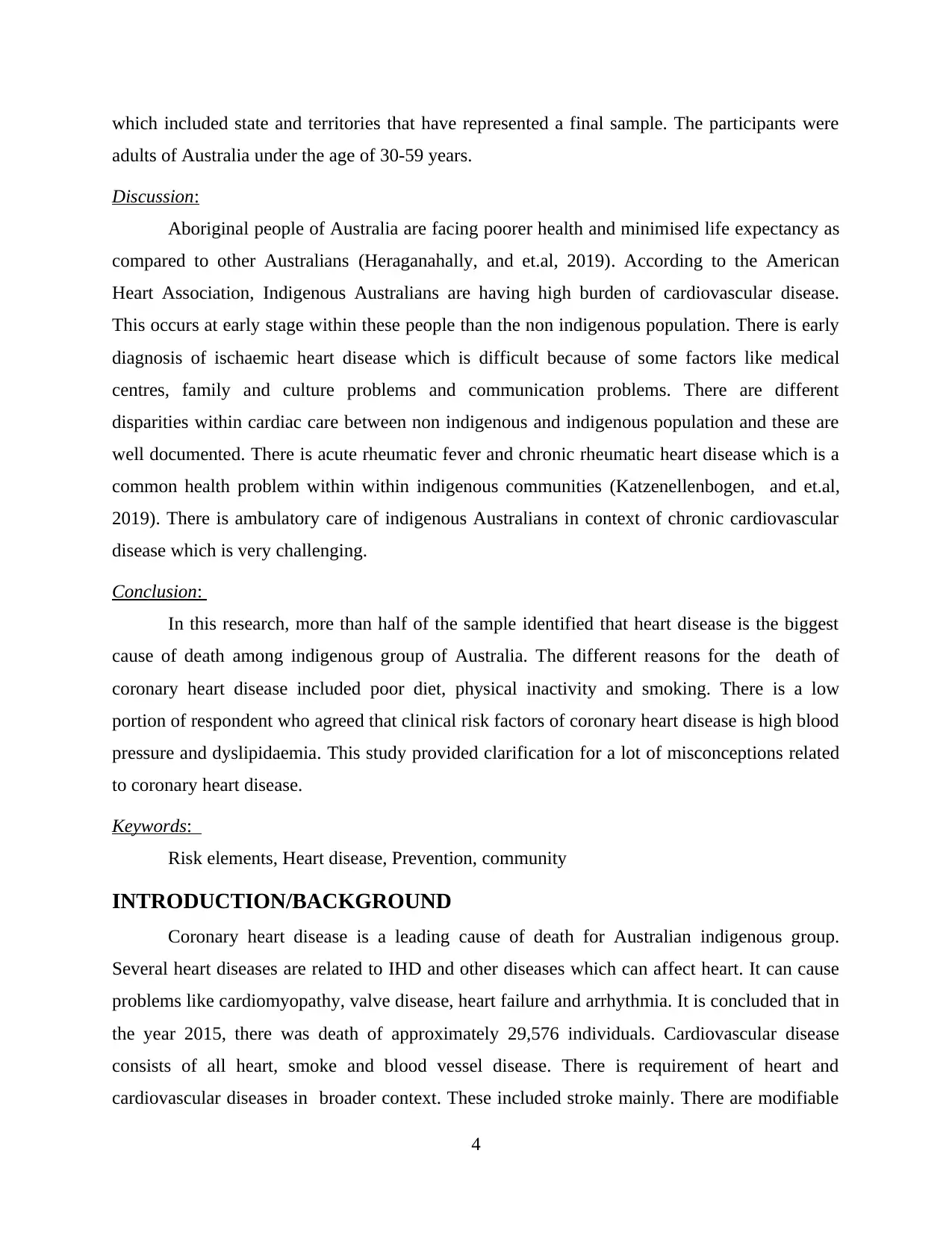
which included state and territories that have represented a final sample. The participants were
adults of Australia under the age of 30-59 years.
Discussion:
Aboriginal people of Australia are facing poorer health and minimised life expectancy as
compared to other Australians (Heraganahally, and et.al, 2019). According to the American
Heart Association, Indigenous Australians are having high burden of cardiovascular disease.
This occurs at early stage within these people than the non indigenous population. There is early
diagnosis of ischaemic heart disease which is difficult because of some factors like medical
centres, family and culture problems and communication problems. There are different
disparities within cardiac care between non indigenous and indigenous population and these are
well documented. There is acute rheumatic fever and chronic rheumatic heart disease which is a
common health problem within within indigenous communities (Katzenellenbogen, and et.al,
2019). There is ambulatory care of indigenous Australians in context of chronic cardiovascular
disease which is very challenging.
Conclusion:
In this research, more than half of the sample identified that heart disease is the biggest
cause of death among indigenous group of Australia. The different reasons for the death of
coronary heart disease included poor diet, physical inactivity and smoking. There is a low
portion of respondent who agreed that clinical risk factors of coronary heart disease is high blood
pressure and dyslipidaemia. This study provided clarification for a lot of misconceptions related
to coronary heart disease.
Keywords:
Risk elements, Heart disease, Prevention, community
INTRODUCTION/BACKGROUND
Coronary heart disease is a leading cause of death for Australian indigenous group.
Several heart diseases are related to IHD and other diseases which can affect heart. It can cause
problems like cardiomyopathy, valve disease, heart failure and arrhythmia. It is concluded that in
the year 2015, there was death of approximately 29,576 individuals. Cardiovascular disease
consists of all heart, smoke and blood vessel disease. There is requirement of heart and
cardiovascular diseases in broader context. These included stroke mainly. There are modifiable
4
adults of Australia under the age of 30-59 years.
Discussion:
Aboriginal people of Australia are facing poorer health and minimised life expectancy as
compared to other Australians (Heraganahally, and et.al, 2019). According to the American
Heart Association, Indigenous Australians are having high burden of cardiovascular disease.
This occurs at early stage within these people than the non indigenous population. There is early
diagnosis of ischaemic heart disease which is difficult because of some factors like medical
centres, family and culture problems and communication problems. There are different
disparities within cardiac care between non indigenous and indigenous population and these are
well documented. There is acute rheumatic fever and chronic rheumatic heart disease which is a
common health problem within within indigenous communities (Katzenellenbogen, and et.al,
2019). There is ambulatory care of indigenous Australians in context of chronic cardiovascular
disease which is very challenging.
Conclusion:
In this research, more than half of the sample identified that heart disease is the biggest
cause of death among indigenous group of Australia. The different reasons for the death of
coronary heart disease included poor diet, physical inactivity and smoking. There is a low
portion of respondent who agreed that clinical risk factors of coronary heart disease is high blood
pressure and dyslipidaemia. This study provided clarification for a lot of misconceptions related
to coronary heart disease.
Keywords:
Risk elements, Heart disease, Prevention, community
INTRODUCTION/BACKGROUND
Coronary heart disease is a leading cause of death for Australian indigenous group.
Several heart diseases are related to IHD and other diseases which can affect heart. It can cause
problems like cardiomyopathy, valve disease, heart failure and arrhythmia. It is concluded that in
the year 2015, there was death of approximately 29,576 individuals. Cardiovascular disease
consists of all heart, smoke and blood vessel disease. There is requirement of heart and
cardiovascular diseases in broader context. These included stroke mainly. There are modifiable
4
Secure Best Marks with AI Grader
Need help grading? Try our AI Grader for instant feedback on your assignments.
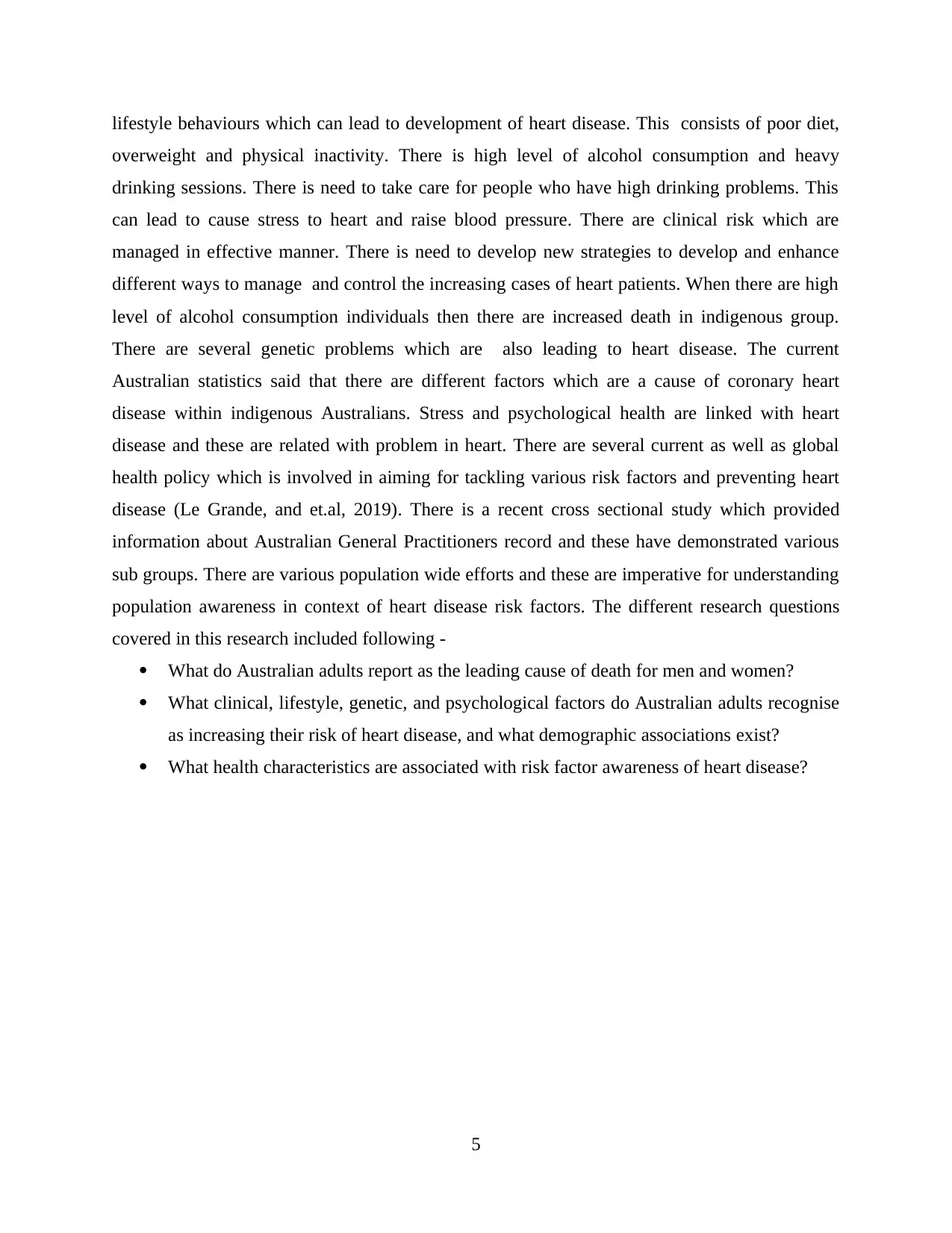
lifestyle behaviours which can lead to development of heart disease. This consists of poor diet,
overweight and physical inactivity. There is high level of alcohol consumption and heavy
drinking sessions. There is need to take care for people who have high drinking problems. This
can lead to cause stress to heart and raise blood pressure. There are clinical risk which are
managed in effective manner. There is need to develop new strategies to develop and enhance
different ways to manage and control the increasing cases of heart patients. When there are high
level of alcohol consumption individuals then there are increased death in indigenous group.
There are several genetic problems which are also leading to heart disease. The current
Australian statistics said that there are different factors which are a cause of coronary heart
disease within indigenous Australians. Stress and psychological health are linked with heart
disease and these are related with problem in heart. There are several current as well as global
health policy which is involved in aiming for tackling various risk factors and preventing heart
disease (Le Grande, and et.al, 2019). There is a recent cross sectional study which provided
information about Australian General Practitioners record and these have demonstrated various
sub groups. There are various population wide efforts and these are imperative for understanding
population awareness in context of heart disease risk factors. The different research questions
covered in this research included following -
What do Australian adults report as the leading cause of death for men and women?
What clinical, lifestyle, genetic, and psychological factors do Australian adults recognise
as increasing their risk of heart disease, and what demographic associations exist?
What health characteristics are associated with risk factor awareness of heart disease?
5
overweight and physical inactivity. There is high level of alcohol consumption and heavy
drinking sessions. There is need to take care for people who have high drinking problems. This
can lead to cause stress to heart and raise blood pressure. There are clinical risk which are
managed in effective manner. There is need to develop new strategies to develop and enhance
different ways to manage and control the increasing cases of heart patients. When there are high
level of alcohol consumption individuals then there are increased death in indigenous group.
There are several genetic problems which are also leading to heart disease. The current
Australian statistics said that there are different factors which are a cause of coronary heart
disease within indigenous Australians. Stress and psychological health are linked with heart
disease and these are related with problem in heart. There are several current as well as global
health policy which is involved in aiming for tackling various risk factors and preventing heart
disease (Le Grande, and et.al, 2019). There is a recent cross sectional study which provided
information about Australian General Practitioners record and these have demonstrated various
sub groups. There are various population wide efforts and these are imperative for understanding
population awareness in context of heart disease risk factors. The different research questions
covered in this research included following -
What do Australian adults report as the leading cause of death for men and women?
What clinical, lifestyle, genetic, and psychological factors do Australian adults recognise
as increasing their risk of heart disease, and what demographic associations exist?
What health characteristics are associated with risk factor awareness of heart disease?
5
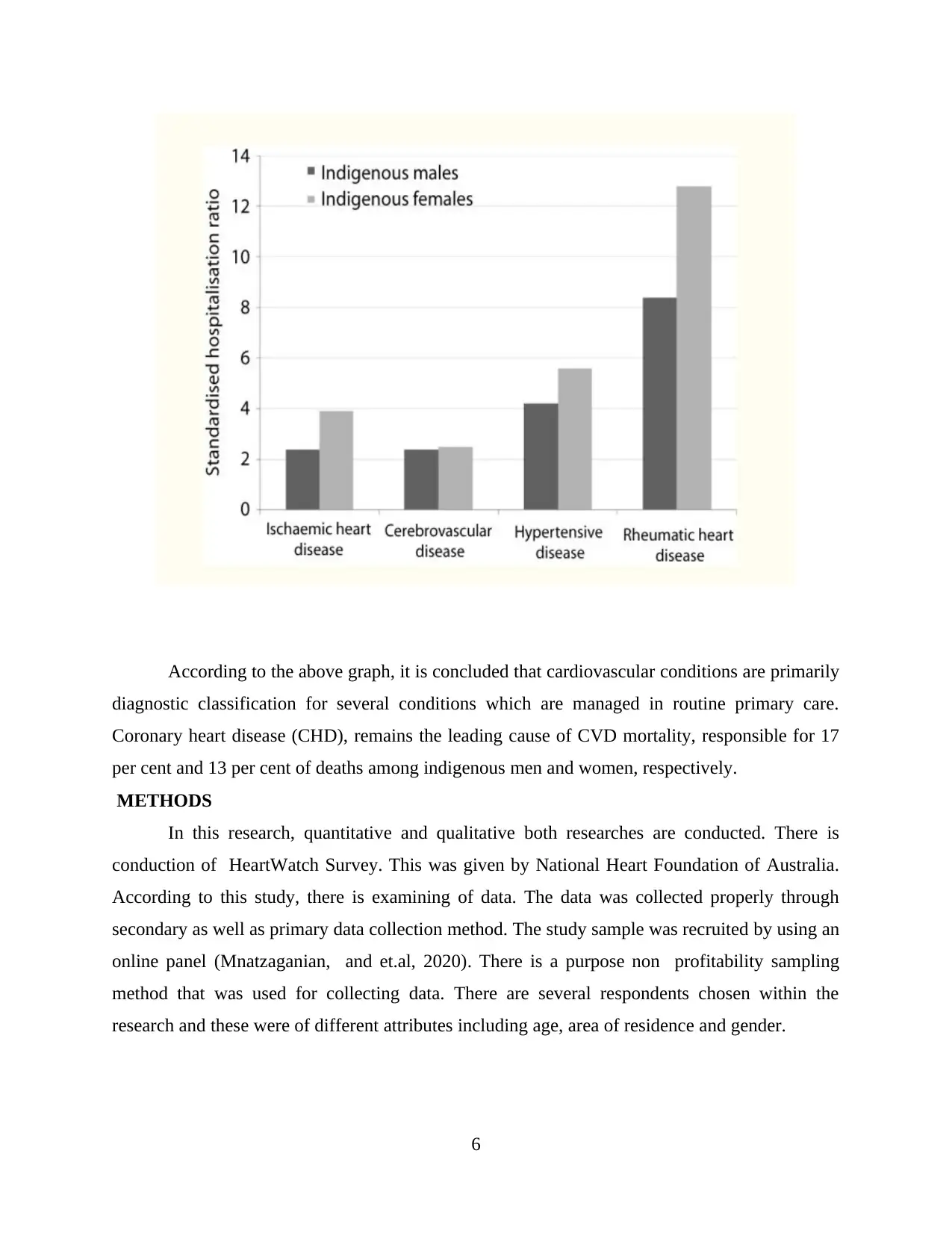
According to the above graph, it is concluded that cardiovascular conditions are primarily
diagnostic classification for several conditions which are managed in routine primary care.
Coronary heart disease (CHD), remains the leading cause of CVD mortality, responsible for 17
per cent and 13 per cent of deaths among indigenous men and women, respectively.
METHODS
In this research, quantitative and qualitative both researches are conducted. There is
conduction of HeartWatch Survey. This was given by National Heart Foundation of Australia.
According to this study, there is examining of data. The data was collected properly through
secondary as well as primary data collection method. The study sample was recruited by using an
online panel (Mnatzaganian, and et.al, 2020). There is a purpose non profitability sampling
method that was used for collecting data. There are several respondents chosen within the
research and these were of different attributes including age, area of residence and gender.
6
diagnostic classification for several conditions which are managed in routine primary care.
Coronary heart disease (CHD), remains the leading cause of CVD mortality, responsible for 17
per cent and 13 per cent of deaths among indigenous men and women, respectively.
METHODS
In this research, quantitative and qualitative both researches are conducted. There is
conduction of HeartWatch Survey. This was given by National Heart Foundation of Australia.
According to this study, there is examining of data. The data was collected properly through
secondary as well as primary data collection method. The study sample was recruited by using an
online panel (Mnatzaganian, and et.al, 2020). There is a purpose non profitability sampling
method that was used for collecting data. There are several respondents chosen within the
research and these were of different attributes including age, area of residence and gender.
6
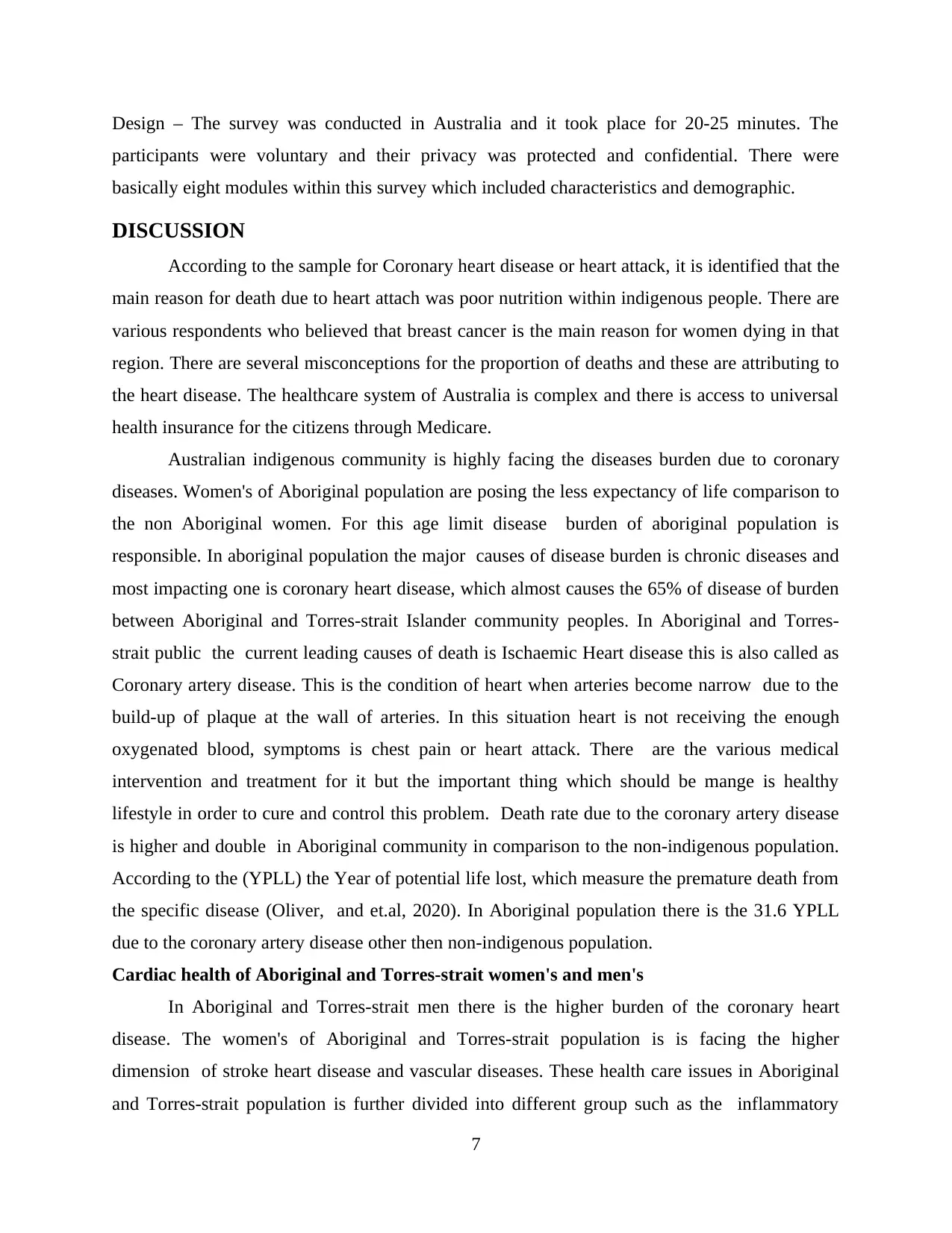
Design – The survey was conducted in Australia and it took place for 20-25 minutes. The
participants were voluntary and their privacy was protected and confidential. There were
basically eight modules within this survey which included characteristics and demographic.
DISCUSSION
According to the sample for Coronary heart disease or heart attack, it is identified that the
main reason for death due to heart attach was poor nutrition within indigenous people. There are
various respondents who believed that breast cancer is the main reason for women dying in that
region. There are several misconceptions for the proportion of deaths and these are attributing to
the heart disease. The healthcare system of Australia is complex and there is access to universal
health insurance for the citizens through Medicare.
Australian indigenous community is highly facing the diseases burden due to coronary
diseases. Women's of Aboriginal population are posing the less expectancy of life comparison to
the non Aboriginal women. For this age limit disease burden of aboriginal population is
responsible. In aboriginal population the major causes of disease burden is chronic diseases and
most impacting one is coronary heart disease, which almost causes the 65% of disease of burden
between Aboriginal and Torres-strait Islander community peoples. In Aboriginal and Torres-
strait public the current leading causes of death is Ischaemic Heart disease this is also called as
Coronary artery disease. This is the condition of heart when arteries become narrow due to the
build-up of plaque at the wall of arteries. In this situation heart is not receiving the enough
oxygenated blood, symptoms is chest pain or heart attack. There are the various medical
intervention and treatment for it but the important thing which should be mange is healthy
lifestyle in order to cure and control this problem. Death rate due to the coronary artery disease
is higher and double in Aboriginal community in comparison to the non-indigenous population.
According to the (YPLL) the Year of potential life lost, which measure the premature death from
the specific disease (Oliver, and et.al, 2020). In Aboriginal population there is the 31.6 YPLL
due to the coronary artery disease other then non-indigenous population.
Cardiac health of Aboriginal and Torres-strait women's and men's
In Aboriginal and Torres-strait men there is the higher burden of the coronary heart
disease. The women's of Aboriginal and Torres-strait population is is facing the higher
dimension of stroke heart disease and vascular diseases. These health care issues in Aboriginal
and Torres-strait population is further divided into different group such as the inflammatory
7
participants were voluntary and their privacy was protected and confidential. There were
basically eight modules within this survey which included characteristics and demographic.
DISCUSSION
According to the sample for Coronary heart disease or heart attack, it is identified that the
main reason for death due to heart attach was poor nutrition within indigenous people. There are
various respondents who believed that breast cancer is the main reason for women dying in that
region. There are several misconceptions for the proportion of deaths and these are attributing to
the heart disease. The healthcare system of Australia is complex and there is access to universal
health insurance for the citizens through Medicare.
Australian indigenous community is highly facing the diseases burden due to coronary
diseases. Women's of Aboriginal population are posing the less expectancy of life comparison to
the non Aboriginal women. For this age limit disease burden of aboriginal population is
responsible. In aboriginal population the major causes of disease burden is chronic diseases and
most impacting one is coronary heart disease, which almost causes the 65% of disease of burden
between Aboriginal and Torres-strait Islander community peoples. In Aboriginal and Torres-
strait public the current leading causes of death is Ischaemic Heart disease this is also called as
Coronary artery disease. This is the condition of heart when arteries become narrow due to the
build-up of plaque at the wall of arteries. In this situation heart is not receiving the enough
oxygenated blood, symptoms is chest pain or heart attack. There are the various medical
intervention and treatment for it but the important thing which should be mange is healthy
lifestyle in order to cure and control this problem. Death rate due to the coronary artery disease
is higher and double in Aboriginal community in comparison to the non-indigenous population.
According to the (YPLL) the Year of potential life lost, which measure the premature death from
the specific disease (Oliver, and et.al, 2020). In Aboriginal population there is the 31.6 YPLL
due to the coronary artery disease other then non-indigenous population.
Cardiac health of Aboriginal and Torres-strait women's and men's
In Aboriginal and Torres-strait men there is the higher burden of the coronary heart
disease. The women's of Aboriginal and Torres-strait population is is facing the higher
dimension of stroke heart disease and vascular diseases. These health care issues in Aboriginal
and Torres-strait population is further divided into different group such as the inflammatory
7
Paraphrase This Document
Need a fresh take? Get an instant paraphrase of this document with our AI Paraphraser
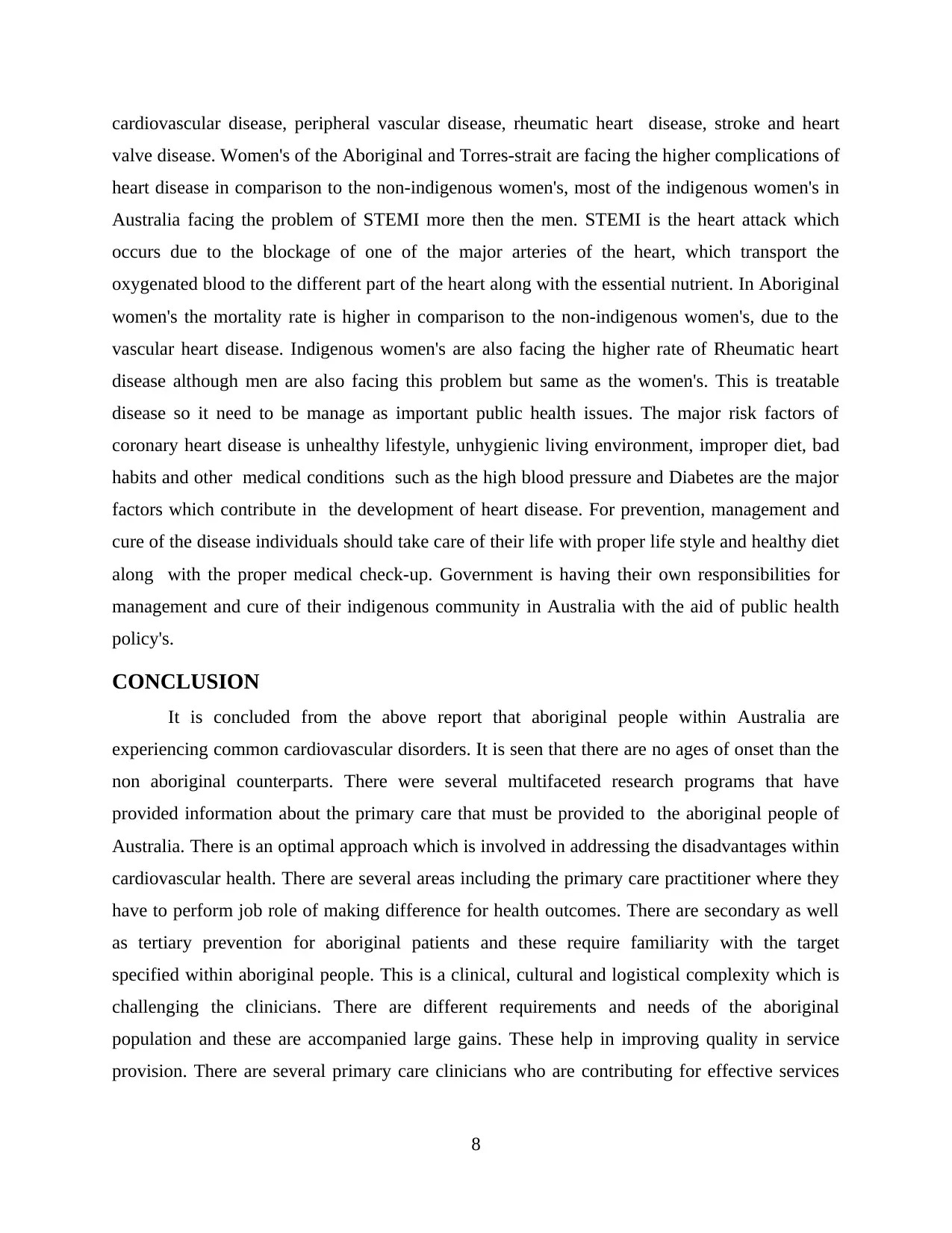
cardiovascular disease, peripheral vascular disease, rheumatic heart disease, stroke and heart
valve disease. Women's of the Aboriginal and Torres-strait are facing the higher complications of
heart disease in comparison to the non-indigenous women's, most of the indigenous women's in
Australia facing the problem of STEMI more then the men. STEMI is the heart attack which
occurs due to the blockage of one of the major arteries of the heart, which transport the
oxygenated blood to the different part of the heart along with the essential nutrient. In Aboriginal
women's the mortality rate is higher in comparison to the non-indigenous women's, due to the
vascular heart disease. Indigenous women's are also facing the higher rate of Rheumatic heart
disease although men are also facing this problem but same as the women's. This is treatable
disease so it need to be manage as important public health issues. The major risk factors of
coronary heart disease is unhealthy lifestyle, unhygienic living environment, improper diet, bad
habits and other medical conditions such as the high blood pressure and Diabetes are the major
factors which contribute in the development of heart disease. For prevention, management and
cure of the disease individuals should take care of their life with proper life style and healthy diet
along with the proper medical check-up. Government is having their own responsibilities for
management and cure of their indigenous community in Australia with the aid of public health
policy's.
CONCLUSION
It is concluded from the above report that aboriginal people within Australia are
experiencing common cardiovascular disorders. It is seen that there are no ages of onset than the
non aboriginal counterparts. There were several multifaceted research programs that have
provided information about the primary care that must be provided to the aboriginal people of
Australia. There is an optimal approach which is involved in addressing the disadvantages within
cardiovascular health. There are several areas including the primary care practitioner where they
have to perform job role of making difference for health outcomes. There are secondary as well
as tertiary prevention for aboriginal patients and these require familiarity with the target
specified within aboriginal people. This is a clinical, cultural and logistical complexity which is
challenging the clinicians. There are different requirements and needs of the aboriginal
population and these are accompanied large gains. These help in improving quality in service
provision. There are several primary care clinicians who are contributing for effective services
8
valve disease. Women's of the Aboriginal and Torres-strait are facing the higher complications of
heart disease in comparison to the non-indigenous women's, most of the indigenous women's in
Australia facing the problem of STEMI more then the men. STEMI is the heart attack which
occurs due to the blockage of one of the major arteries of the heart, which transport the
oxygenated blood to the different part of the heart along with the essential nutrient. In Aboriginal
women's the mortality rate is higher in comparison to the non-indigenous women's, due to the
vascular heart disease. Indigenous women's are also facing the higher rate of Rheumatic heart
disease although men are also facing this problem but same as the women's. This is treatable
disease so it need to be manage as important public health issues. The major risk factors of
coronary heart disease is unhealthy lifestyle, unhygienic living environment, improper diet, bad
habits and other medical conditions such as the high blood pressure and Diabetes are the major
factors which contribute in the development of heart disease. For prevention, management and
cure of the disease individuals should take care of their life with proper life style and healthy diet
along with the proper medical check-up. Government is having their own responsibilities for
management and cure of their indigenous community in Australia with the aid of public health
policy's.
CONCLUSION
It is concluded from the above report that aboriginal people within Australia are
experiencing common cardiovascular disorders. It is seen that there are no ages of onset than the
non aboriginal counterparts. There were several multifaceted research programs that have
provided information about the primary care that must be provided to the aboriginal people of
Australia. There is an optimal approach which is involved in addressing the disadvantages within
cardiovascular health. There are several areas including the primary care practitioner where they
have to perform job role of making difference for health outcomes. There are secondary as well
as tertiary prevention for aboriginal patients and these require familiarity with the target
specified within aboriginal people. This is a clinical, cultural and logistical complexity which is
challenging the clinicians. There are different requirements and needs of the aboriginal
population and these are accompanied large gains. These help in improving quality in service
provision. There are several primary care clinicians who are contributing for effective services
8

and these are enabling comprehensive care beginning at the early stage of life of these
individuals.
9
individuals.
9
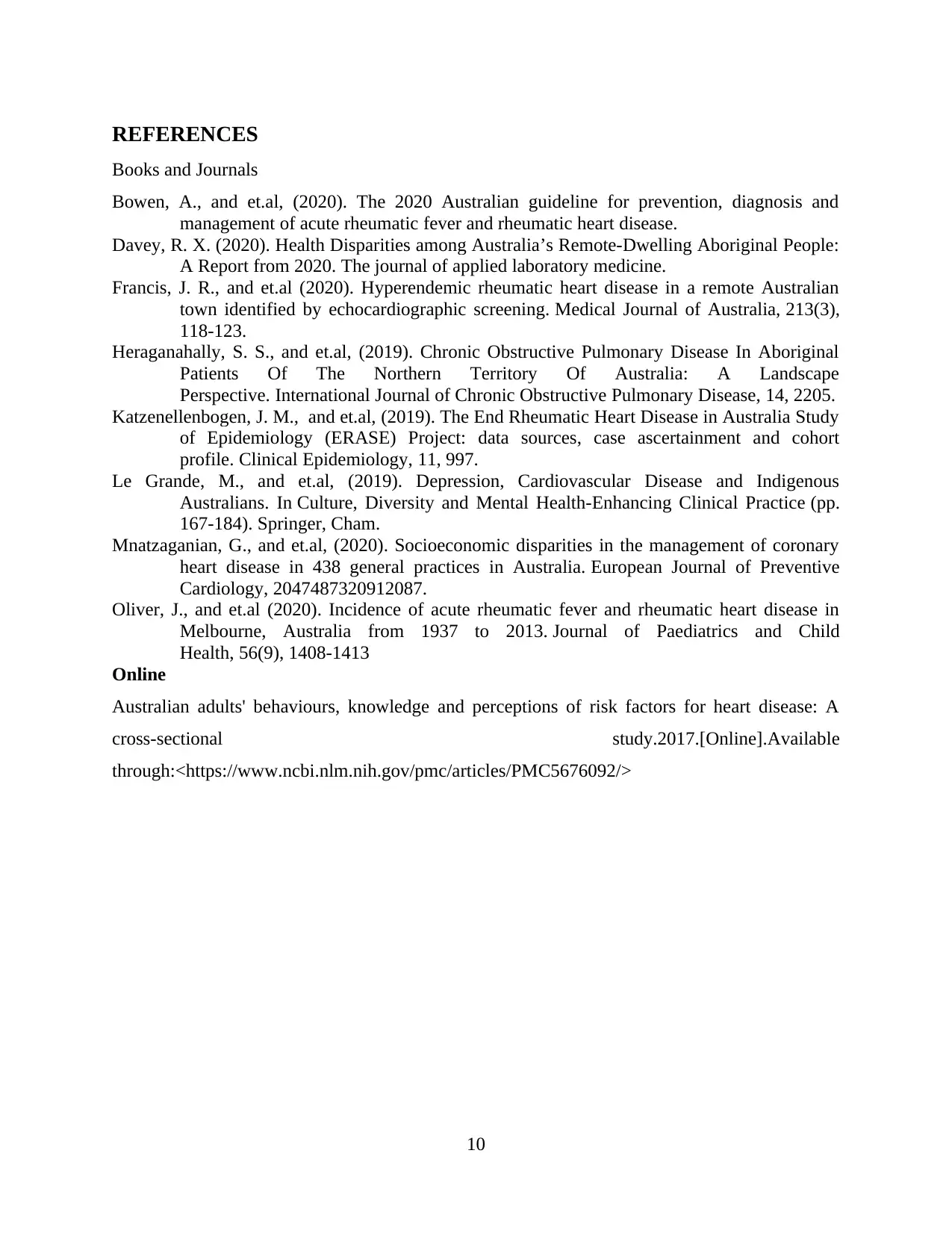
REFERENCES
Books and Journals
Bowen, A., and et.al, (2020). The 2020 Australian guideline for prevention, diagnosis and
management of acute rheumatic fever and rheumatic heart disease.
Davey, R. X. (2020). Health Disparities among Australia’s Remote-Dwelling Aboriginal People:
A Report from 2020. The journal of applied laboratory medicine.
Francis, J. R., and et.al (2020). Hyperendemic rheumatic heart disease in a remote Australian
town identified by echocardiographic screening. Medical Journal of Australia, 213(3),
118-123.
Heraganahally, S. S., and et.al, (2019). Chronic Obstructive Pulmonary Disease In Aboriginal
Patients Of The Northern Territory Of Australia: A Landscape
Perspective. International Journal of Chronic Obstructive Pulmonary Disease, 14, 2205.
Katzenellenbogen, J. M., and et.al, (2019). The End Rheumatic Heart Disease in Australia Study
of Epidemiology (ERASE) Project: data sources, case ascertainment and cohort
profile. Clinical Epidemiology, 11, 997.
Le Grande, M., and et.al, (2019). Depression, Cardiovascular Disease and Indigenous
Australians. In Culture, Diversity and Mental Health-Enhancing Clinical Practice (pp.
167-184). Springer, Cham.
Mnatzaganian, G., and et.al, (2020). Socioeconomic disparities in the management of coronary
heart disease in 438 general practices in Australia. European Journal of Preventive
Cardiology, 2047487320912087.
Oliver, J., and et.al (2020). Incidence of acute rheumatic fever and rheumatic heart disease in
Melbourne, Australia from 1937 to 2013. Journal of Paediatrics and Child
Health, 56(9), 1408-1413
Online
Australian adults' behaviours, knowledge and perceptions of risk factors for heart disease: A
cross-sectional study.2017.[Online].Available
through:<https://www.ncbi.nlm.nih.gov/pmc/articles/PMC5676092/>
10
Books and Journals
Bowen, A., and et.al, (2020). The 2020 Australian guideline for prevention, diagnosis and
management of acute rheumatic fever and rheumatic heart disease.
Davey, R. X. (2020). Health Disparities among Australia’s Remote-Dwelling Aboriginal People:
A Report from 2020. The journal of applied laboratory medicine.
Francis, J. R., and et.al (2020). Hyperendemic rheumatic heart disease in a remote Australian
town identified by echocardiographic screening. Medical Journal of Australia, 213(3),
118-123.
Heraganahally, S. S., and et.al, (2019). Chronic Obstructive Pulmonary Disease In Aboriginal
Patients Of The Northern Territory Of Australia: A Landscape
Perspective. International Journal of Chronic Obstructive Pulmonary Disease, 14, 2205.
Katzenellenbogen, J. M., and et.al, (2019). The End Rheumatic Heart Disease in Australia Study
of Epidemiology (ERASE) Project: data sources, case ascertainment and cohort
profile. Clinical Epidemiology, 11, 997.
Le Grande, M., and et.al, (2019). Depression, Cardiovascular Disease and Indigenous
Australians. In Culture, Diversity and Mental Health-Enhancing Clinical Practice (pp.
167-184). Springer, Cham.
Mnatzaganian, G., and et.al, (2020). Socioeconomic disparities in the management of coronary
heart disease in 438 general practices in Australia. European Journal of Preventive
Cardiology, 2047487320912087.
Oliver, J., and et.al (2020). Incidence of acute rheumatic fever and rheumatic heart disease in
Melbourne, Australia from 1937 to 2013. Journal of Paediatrics and Child
Health, 56(9), 1408-1413
Online
Australian adults' behaviours, knowledge and perceptions of risk factors for heart disease: A
cross-sectional study.2017.[Online].Available
through:<https://www.ncbi.nlm.nih.gov/pmc/articles/PMC5676092/>
10
1 out of 10
Related Documents
Your All-in-One AI-Powered Toolkit for Academic Success.
+13062052269
info@desklib.com
Available 24*7 on WhatsApp / Email
![[object Object]](/_next/static/media/star-bottom.7253800d.svg)
Unlock your academic potential
© 2024 | Zucol Services PVT LTD | All rights reserved.





